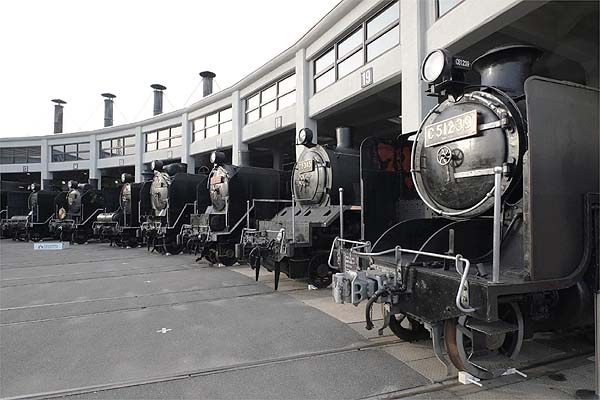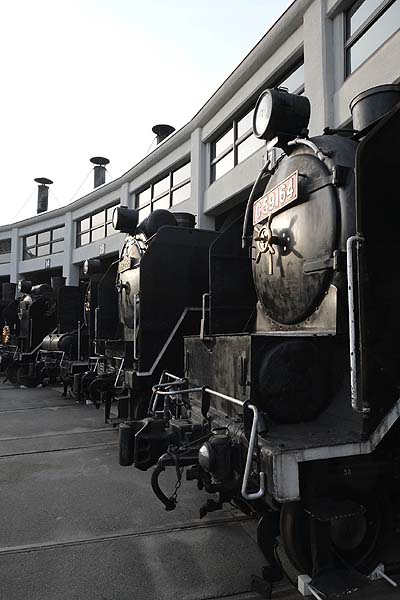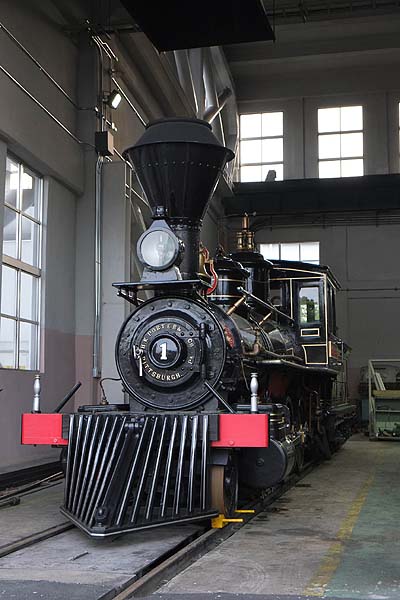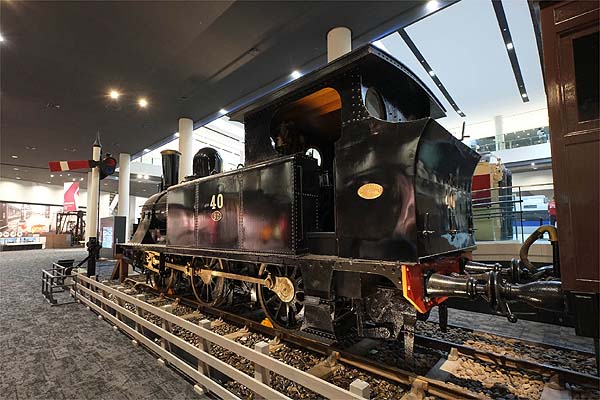|
The Kyoto Railway Museum, 2016 |
|
|
James Waite reports on this newly opened attraction in Japan which he visited on 5th May 2016. If you are visiting Kyoto, don't forget the small museum at Saga Torokko, Kyoto on the Sagano Scenic Railway, read Gianfrancesco Capoferri's photo report of the steam exhibits. Basically it's an enlargement of the old Umekoji Steam Locomotive Museum to accommodate a lot of diesel and electric exhibits. It reopened after a long period of closure during the last week of April and is a really good place. We got there six days later. The new exhibits are housed in two enormous new halls and most of the steam locomotives are housed in the old Umekoji roundhouse, one of the major locomotive depots in the west of Japan in steam days. It dates from 1916 and is one of the oldest in Japan. As you can see from the pictures which speak for themselves, altogether this is a remarkable place and one that was quite extraordinarily busy. It opened at 9.00am during the week that we were in Kyoto (a holiday week, normally it opens at 10.00) and we thought that if we arrived a few minutes before 9.00 we would have a little while to look around without other people being around. Far from it, there was something of a tidal wave of people walking along the path through the park leading to the museum and when we arrived there must have been well over 1,000 people in the queue for tickets. Railways in general and steam locomotives in particular are very popular in Japan. A member of staff attends to the brake pipe of 2-8-0 no. 9633 with 2-6-4T no C11 64 behind. The 9600's were the first successful freight locomotives to be built in Japan and also the first locomotives to be mass-produced. 770 were built between 1913 and 1926 and 48 have been preserved though none of them are in working order. 381 C11's were built between 1932 and 1947. 50 have been preserved including 5 that are currently in working order.
This curious-looking 4-4-2T is the only British-built locomotive in the roundhouse display. The JNR and its state-run predecessors had a large number of Beyer-Peacock-designed 4-4-0's and several of this tank locomotive version. They were actually built by several manufacturers. This one was built by Dubs in 1900 as a 4-4-0 and was rebuilt to its present form in 1926. It was sold off by the JNR to a coal company where it continued to work into the 1970's and was presented to the museum eight years ago.
Four locomotives outside the roundhouse. B20 10 was one of 15 0-4-0T's built between 1944 and 1947 specifically for use as shed pilots. D51 1 was the prototype of the 1,115 D51 Mikados built between 1936 and 1944 - after which others were built for the Soviet railways on Sakhalin and for the Taiwan railway. Many lasted until the end of steam in the mid-1970's. No fewer than 170 have been preserved in Japan and there are more on Sakhalin and Taiwan.
C62 26 is one of 49 Hudson 4-6-4s built in 1948 and 1949 using boilers from redundant D52 Mikados. They were the largest passenger locomotives on the JNR system and lasted until the end of steam in the mid-1970's. The rebuilding came about as the JNR had a surplus of heavy freight locomotives after much of the country's industry had been destroyed in WW2 and an urgent need for more passenger locomotives. Three of these locomotives are preserved at the museum including this one.
C62 2 which was in steam, though in an awkward position for the sun. If you ever go there the sun would be right in the early to mid-afternoon. I went back later in the day, arriving about 16.30 but it had already been put to bed for the day.
2-6-0 no. 8630 is another locomotive preserved in working order. 687 of these 8620 class locomotives were built between 1914 and 1929 and this is another class that was also built for Sakhalin and Taiwan. 22 have been preserved.
Another lineup, this time at dusk. The nearest locomotive is Pacific no. C51 239, one of only three survivors of the 289 locomotives in this class, the first Japanese-built Pacifics which appeared between 1919 and 1928.
The C53's were the country's first 3-cylinder Pacifics. 97 were built between 1928 and 1931 and C53 45 is the only survivor. Beyond it is C59 164. These were also 3-cylinder Pacifics developed from the C53's. 173 were built between 1941 and 1945.
C59 164 again. Only 4 of these locomotives have survived. Beyond it is Mikado D52 468. The D52's were an enlarged version of the D51 and were the heaviest freight locomotives on the system. 285 were built between 1943 and 1946. Apparently the Deutsche Reichsbahn may have had some input into the design and most of the principal dimensions are the same as the Kriegsloks though they look very different. 7 have been preserved.
C58 1 was the prototype of the 427 C58 class 2-6-2's built between 1938 and 1947. 48 have been preserved including 2 in working order.
A view over the east end of the museum yard. The partially stripped-down locomotive on the right is 4-6-4 no. C61 2, one of 33 of these locomotives rebuilt from D51's between 1947 and 1949. No. 8630 is on the left and out on the line there are a narrow gauge emu set and a Shinkansen train heading west from Kyoto station.
This is the Horonai Railway's no 1 "Yoshitsune", a Mogul built by H.K. Porter in 1880. Eight of these locomotives were built between 1880 and 1889 and no fewer than three have been preserved. This one is in working order.
A view of the three locomotives at the museum currently in service - cunningly positioned to hide the silly headboards which the two modern locomotives were carrying! The one in the middle is 2-6-0 C56 160, one of the class which were shipped out in large numbers during WW2 to the railways of SE Asia, though this one never left Japan.
Three views of 2-4-2T no. 233 (Kisha Seizo Kwaisha 11/1903), one of the first Japanese-built locomotives. Its design was based on a series of Sharp Stewart 2-4-2T's.
Two views of B2 class 0-6-0T no 40 (Kitson 2453/1881), the only other British-built locomotive in the museum apart from the 4-4-2T.
The new repair shop at the museum with D51 200 undergoing overhaul.
|
|



















